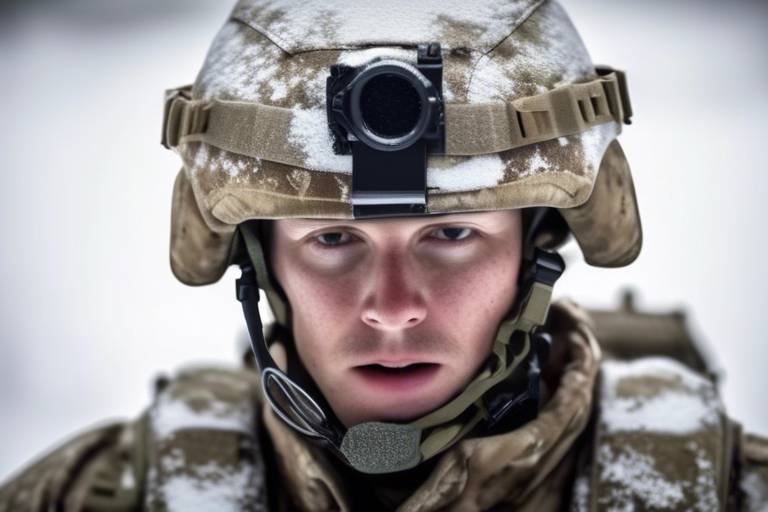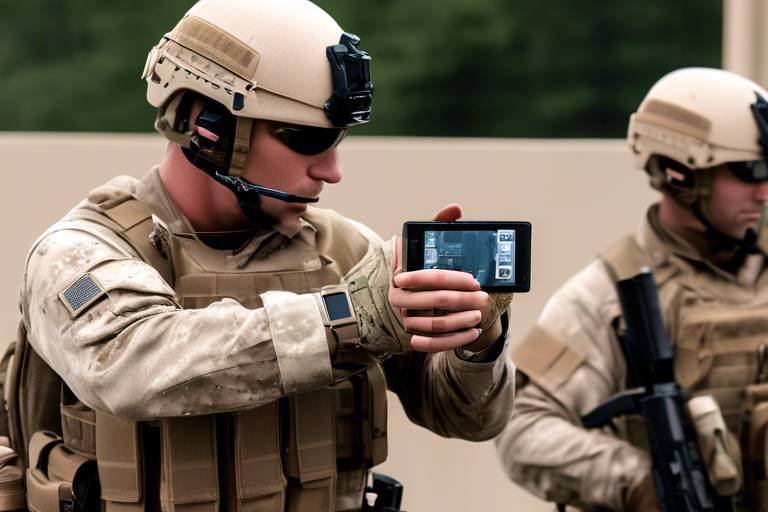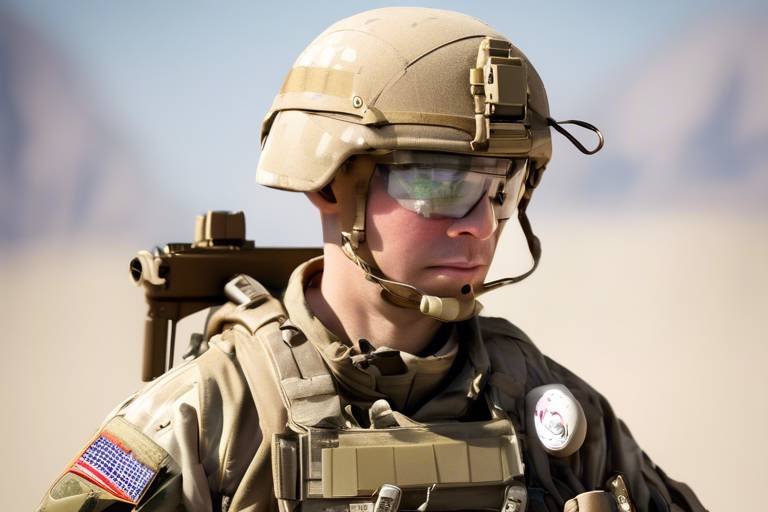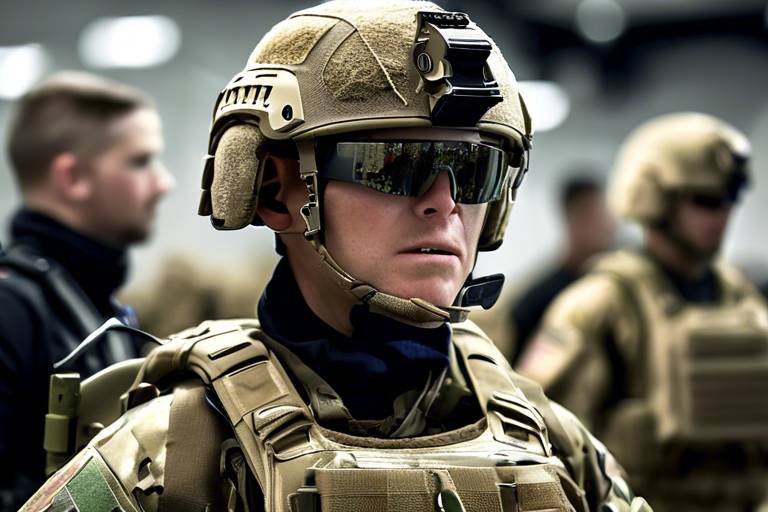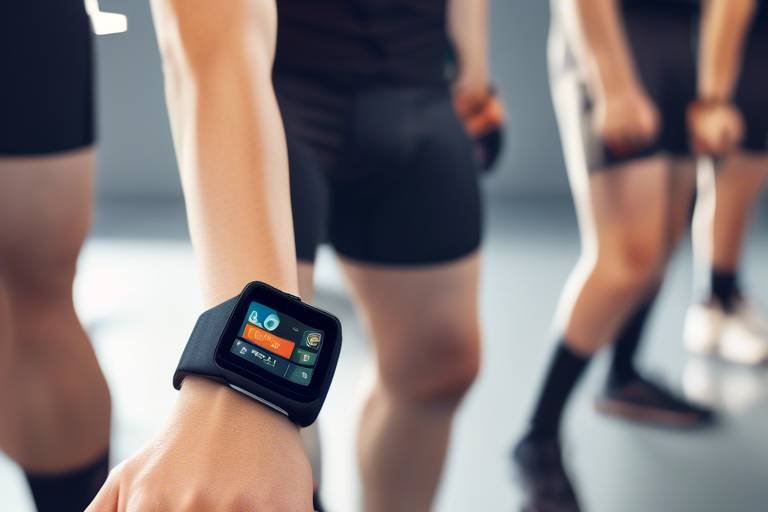How Wearable Technology Affects Soldier Morale
In today's fast-paced world, wearable technology has carved out a significant niche in various sectors, and the military is no exception. Imagine a soldier equipped with a device that not only tracks their physical health but also enhances their situational awareness during a mission. This is not a scene from a sci-fi movie; it’s the reality of modern warfare. The integration of such technology into military operations has profound effects on soldier morale, often acting as a double-edged sword. While it can uplift spirits and boost confidence, it also presents challenges that can lead to stress and distraction. So, how does this cutting-edge tech truly affect the men and women on the front lines? Let’s dive deeper into this intriguing topic.
Wearable technology has become integral in modern warfare, providing soldiers with real-time data and enhancing their situational awareness, which can significantly boost morale during missions. Think about it: in the heat of battle, having access to crucial information at your fingertips can be a game-changer. Soldiers equipped with smartwatches or health monitors can receive updates about their physical condition, location, and even the status of their comrades. This instant access to information not only keeps them informed but also fosters a sense of security and preparedness. When soldiers feel equipped to handle their environment, it naturally leads to increased confidence and morale.
The psychological advantages of wearable devices are profound and multifaceted. One of the most significant benefits is the improvement in mental health. In high-stress environments, soldiers often grapple with anxiety and uncertainty. Wearable devices can help mitigate these feelings by offering features aimed at stress management and emotional support. For example, many devices come equipped with breathing exercises or mindfulness programs that soldiers can use on the go. This ability to manage stress effectively contributes to a more positive mental state, ultimately enhancing overall morale.
Real-time health monitoring is another critical aspect of wearable technology. Soldiers can receive immediate feedback on their physical condition, which can lead to increased safety during operations. Imagine being in a high-pressure situation and knowing that your heart rate and stress levels are being monitored. This feedback allows soldiers to make informed decisions about their health and performance, reducing the risk of exhaustion or injury. When soldiers feel safe and aware of their physical status, their confidence soars, and so does their morale.
Many wearable devices are designed with stress management features that help soldiers cope with anxiety and pressure. These tools can include guided meditations, relaxation techniques, and even alerts when stress levels rise. By promoting a more positive mental state, these features play a crucial role in maintaining high morale. Picture a soldier in the field, taking a moment to breathe deeply and center themselves before a mission. This brief pause can make all the difference in their performance and mindset.
Another significant benefit of wearable technology is the enhancement of communication among team members. Wearable devices can facilitate seamless communication, allowing soldiers to stay connected even in the most chaotic environments. This connectivity fosters camaraderie and support, which are vital for uplifting soldiers' spirits in challenging situations. When team members can communicate effectively, it strengthens their bond and reinforces their shared goals, ultimately leading to improved morale.
The integration of wearable technology can significantly strengthen team cohesion. By promoting shared goals and experiences, these devices create a sense of unity among soldiers. When everyone is on the same page, working towards a common objective, it boosts morale and effectiveness in missions. The technology acts as a glue, binding the team together and enhancing their collective resilience. In a world where trust and cooperation are paramount, wearable technology can be the catalyst for a more cohesive and motivated unit.
Despite its myriad benefits, wearable technology presents challenges that cannot be overlooked. Issues such as potential distractions, privacy concerns, and over-reliance on technology can negatively affect soldier morale if not managed properly. It’s essential to strike a balance between utilizing the advantages of these devices and ensuring they do not become a hindrance.
The potential for distraction from wearable devices can hinder soldiers' focus. If a soldier becomes overly reliant on their device for information, it can lead to decreased morale, especially if they feel overwhelmed or unable to perform their duties effectively. Imagine a soldier in the middle of a critical operation, constantly checking their device for updates instead of focusing on the task at hand. This scenario can lead to mistakes and a sense of inadequacy, which can severely impact morale.
Concerns regarding privacy and data security can create distrust among soldiers. If soldiers feel that their personal information is not secure or that they are being monitored excessively, it can impact their morale and willingness to engage with wearable technology in the field. Trust is crucial in any military operation, and any breach of that trust can lead to significant morale issues.
- How does wearable technology improve soldier safety?
Wearable technology allows for real-time health monitoring and situational awareness, helping soldiers stay informed about their physical condition and surroundings. - Can wearable devices help manage stress?
Yes, many wearable devices include stress management features such as guided breathing exercises and mindfulness tools to help soldiers cope with anxiety. - What are the risks associated with wearable technology in the military?
Potential distractions, privacy concerns, and over-reliance on technology can negatively impact soldier morale if not managed properly.
The Role of Wearable Technology in Modern Warfare
In today's fast-paced and ever-evolving battlefield, wearable technology has emerged as a game-changer for military personnel. Imagine a soldier equipped with a device that not only tracks their physical condition but also provides them with critical data about their surroundings in real-time. This integration of technology into military operations is not just a trend; it's a necessity that enhances operational efficiency and boosts morale during missions.
Wearable devices, such as smartwatches and fitness trackers, are now standard issue in many military units. These gadgets are designed to collect a plethora of data, from heart rate and body temperature to location and environmental conditions. This influx of information can significantly enhance a soldier's situational awareness, allowing them to make informed decisions quickly. For instance, if a soldier is experiencing elevated stress levels, they can receive alerts that prompt them to take necessary actions to manage their condition. This proactive approach not only ensures their safety but also fosters a sense of control and confidence in their abilities.
Moreover, the use of wearable technology can facilitate better communication among team members. Imagine a scenario where soldiers in a squad can share vital information instantly, whether it's a change in mission parameters or updates on enemy movements. This seamless communication fosters a sense of unity and camaraderie, which is crucial in high-stress environments. When soldiers feel connected and supported by their peers, their morale naturally increases, making them more effective in carrying out their duties.
In addition to enhancing communication, these devices often come equipped with features that promote physical fitness and mental well-being. For example, some wearables include reminders for hydration, exercise, or even mindfulness breaks. These features serve as gentle nudges to maintain a healthy lifestyle, which is essential for soldiers operating under extreme conditions. By prioritizing their health, soldiers can improve their performance and resilience, further elevating their morale.
To illustrate the impact of wearable technology on soldier morale, consider the following table:
| Feature | Benefit |
|---|---|
| Real-Time Monitoring | Increased safety and awareness |
| Stress Management Tools | Enhanced mental health and resilience |
| Seamless Communication | Stronger team cohesion and support |
| Health Reminders | Promotion of overall well-being |
As we can see, the role of wearable technology in modern warfare extends beyond mere functionality; it plays a pivotal role in shaping the psychological landscape of military operations. By providing soldiers with the tools they need to monitor their health, communicate effectively, and maintain a strong sense of camaraderie, wearable devices are helping to create a more resilient and motivated fighting force.
- What types of wearable technology are used by soldiers? Soldiers commonly use smartwatches, fitness trackers, and specialized military-grade devices that offer real-time data and communication capabilities.
- How does wearable technology improve soldier safety? By providing real-time health monitoring and situational awareness, wearable technology helps soldiers make informed decisions, ultimately enhancing their safety on the battlefield.
- Can wearable technology help with stress management? Yes, many wearable devices include features designed to help manage stress, such as breathing exercises, mindfulness reminders, and alerts for physical activity.
In the high-stakes world of military operations, the psychological well-being of soldiers is paramount. Enter wearable technology, a game-changer that not only tracks physical health but also uplifts mental health. Imagine being on the battlefield, where every second counts, and having a device that keeps you informed about your body's status. This real-time feedback can be a massive morale booster, giving soldiers the confidence to push through even the toughest conditions. It's like having a personal coach right on your wrist, constantly cheering you on!
One of the most significant psychological advantages of these devices is their ability to enhance mental health. Soldiers often face extreme stress and anxiety, and wearable technology can help mitigate these feelings. For instance, many devices come equipped with features that monitor stress levels through heart rate variability and other metrics. When soldiers can see their stress levels in real-time, they can take proactive steps—like practicing deep breathing or taking a moment to regroup—before things escalate. This capability transforms the way they handle pressure, leading to a more positive mental state and, ultimately, higher morale.
Moreover, the increased confidence that comes from knowing one's physical condition cannot be overstated. Soldiers equipped with wearables can track their physical performance and recovery, allowing them to push their limits while also understanding when to pull back. This balance is crucial; it’s like knowing when to push the accelerator and when to ease off the gas in a race. With this knowledge, soldiers can perform at their best without the fear of overexertion, leading to a more empowered mindset.
The feature of real-time health monitoring is perhaps the most transformative aspect of wearable technology. Soldiers can receive immediate feedback on vital signs, hydration levels, and fatigue. This capability allows them to make informed decisions about their health on the fly. For example, if a soldier's heart rate spikes during a mission, they can take a moment to assess their condition rather than pushing through potentially dangerous symptoms. This immediate awareness not only enhances safety but also fosters a sense of control, which is vital for morale.
Many wearables now come equipped with built-in stress management tools. These features can include guided breathing exercises, mindfulness prompts, and even reminders to take breaks. When soldiers are under duress, having these tools at their fingertips can make a world of difference. They can quickly engage in a brief mindfulness exercise to reset their mental state, much like a quick pit stop in a race that helps refuel and recharge. This proactive approach to mental health promotes resilience, allowing soldiers to maintain a positive outlook even in challenging situations.
Another psychological benefit of wearable technology is its ability to facilitate enhanced communication among team members. Many devices allow for instant messaging or alerts, which can keep teams connected even in the chaos of the battlefield. This seamless communication fosters a sense of camaraderie and support, which is crucial for maintaining morale. When soldiers feel connected to their peers, they are more likely to support one another, share experiences, and build a strong team dynamic. It’s like having a safety net that catches you when you fall, providing emotional support that can be a lifeline in high-pressure situations.
In summary, the psychological benefits of wearable devices in the military context are profound. From real-time health monitoring to stress management features and enhanced communication, these technologies not only improve physical performance but also significantly boost soldier morale. They empower soldiers to take control of their mental and physical health, creating a more resilient and cohesive unit ready to tackle any challenge.
- How do wearable devices improve soldier morale?
Wearable devices provide real-time health monitoring, stress management tools, and enhanced communication, all of which contribute to improved mental health and confidence. - Can wearables distract soldiers during missions?
While wearables offer many benefits, they can also be a source of distraction if not managed properly. It's important for soldiers to balance technology use with their focus on the mission. - Are there privacy concerns with wearable technology in the military?
Yes, privacy and data security are significant concerns. Soldiers need to trust that their personal data is secure to fully engage with wearable technology.
Real-Time Health Monitoring
In today’s fast-paced military environment, has emerged as a game changer for soldiers on the front lines. Imagine being able to track your heart rate, body temperature, and even hydration levels, all while engaged in a critical mission. This is not science fiction; it's the reality brought forth by wearable technology. By providing instant feedback on their physical condition, soldiers can make informed decisions that could mean the difference between success and failure in high-stakes situations.
One of the most compelling aspects of real-time health monitoring is its ability to enhance soldier safety. For example, if a soldier's heart rate spikes unexpectedly, it could indicate stress or potential health issues that need immediate attention. This immediate awareness allows for timely interventions, ensuring that soldiers remain in optimal condition to carry out their duties. The psychological boost that comes from knowing that their health is being monitored can also significantly enhance their morale. They feel supported, both by their technology and their team, which fosters a sense of security.
Moreover, the data collected can be invaluable for commanders and medical personnel, providing insights into the overall health of the unit. By analyzing trends in health data, leaders can identify when their troops may be at risk of burnout or physical exhaustion. This proactive approach not only helps in managing the troops more effectively but also contributes to a culture of care and concern within the ranks. Soldiers are more likely to feel valued and understood when they know their well-being is a priority.
However, it's essential to remember that with great power comes great responsibility. The implementation of real-time health monitoring must be done with careful consideration of privacy and data security. Soldiers need to trust that their personal health information is secure and used solely for their benefit. This trust is crucial; if soldiers feel their data is mishandled or exploited, it can lead to a decline in morale and a reluctance to fully embrace the technology designed to help them.
In summary, real-time health monitoring through wearable technology not only enhances physical safety but also significantly uplifts soldier morale. By ensuring that soldiers feel supported and valued, the military can foster a more resilient and effective fighting force. As technology continues to evolve, the potential for further advancements in health monitoring will only enhance the capabilities and well-being of our brave men and women in uniform.
- How does real-time health monitoring work? Wearable devices track various health metrics such as heart rate, temperature, and activity levels, providing instant feedback to the user and their command structure.
- What are the psychological benefits of using wearable technology? Wearable technology can improve mental health, increase confidence, and enhance communication among soldiers, contributing to overall morale.
- Are there privacy concerns associated with wearable technology? Yes, there are concerns regarding data security and privacy that need to be addressed to ensure soldiers feel comfortable using these devices.
- Can real-time health monitoring prevent injuries? By providing immediate feedback on a soldier's physical condition, it can help prevent injuries by alerting them to potential health risks.
Stress Management Features
In the high-stakes world of military operations, stress can be a formidable enemy. Fortunately, wearable technology has stepped up to the plate, offering innovative that help soldiers navigate the mental challenges they face. Imagine being in a high-pressure situation where every second counts, and suddenly, your wrist vibrates to alert you to take a deep breath. These devices are not just about tracking physical activity; they are also about enhancing mental resilience.
Many modern wearable devices come equipped with features designed specifically to help manage stress levels. For example, some wearables offer guided breathing exercises, meditation prompts, and even real-time stress level monitoring through heart rate variability. This feedback can be crucial; when soldiers can see their stress levels in real-time, it empowers them to take proactive steps to calm themselves down. Think of it like having a personal coach on your wrist, reminding you to stay focused and composed when the pressure is on.
Moreover, these devices often provide notifications for taking breaks or engaging in mindfulness exercises, which can significantly improve a soldier's mental state. A simple reminder to step back and breathe can be the difference between a clear mind and a foggy one. By incorporating these stress management features, wearable technology not only enhances individual performance but also contributes to a more cohesive team environment. When soldiers feel supported in managing their stress, their overall morale improves, leading to a more effective and united front during missions.
In addition to these features, many wearables have community aspects that allow soldiers to share their experiences and coping strategies. This creates a sense of camaraderie, as they can support one another in managing stress. After all, who better to understand the challenges of military life than fellow soldiers? This collective approach to stress management fosters an environment where individuals can thrive, even in the most challenging circumstances.
To illustrate the impact of these stress management features, let's take a look at a comparison of traditional stress management techniques versus those offered through wearable technology:
| Traditional Techniques | Wearable Technology Features |
|---|---|
| Manual stress assessments | Real-time stress monitoring |
| Scheduled breaks | Automated reminders for breaks |
| Group therapy sessions | Community support features |
| Static meditation practices | Guided meditation and breathing exercises |
In conclusion, the stress management features of wearable technology are revolutionizing how soldiers cope with the pressures of military life. By providing real-time feedback, automated reminders, and community support, these devices not only enhance individual resilience but also strengthen the bonds between team members. As military operations continue to evolve, the integration of such technology will likely play a pivotal role in maintaining soldier morale and effectiveness.
- What types of stress management features are commonly found in wearable technology? Most wearables include guided breathing exercises, heart rate monitoring, and notifications for mindfulness practices.
- How do these features improve soldier morale? By empowering soldiers to manage their stress proactively, these features enhance mental resilience and promote a supportive team environment.
- Can wearable technology replace traditional stress management techniques? While wearables offer valuable tools, they are best used in conjunction with traditional techniques for a comprehensive approach to stress management.
Enhanced Communication
In the fast-paced environment of modern warfare, effective communication is not just a luxury; it's a necessity. Wearable technology has revolutionized the way soldiers communicate with one another, bridging gaps that once seemed insurmountable. Imagine a battlefield where every soldier is equipped with a device that allows them to share information instantly, regardless of their location. This capability not only enhances operational efficiency but also fosters a sense of unity and camaraderie among team members.
With features like voice commands, real-time messaging, and location tracking, these wearable devices ensure that soldiers can stay in touch without the need for cumbersome equipment. This seamless communication allows for rapid decision-making, which is crucial during high-stakes situations. For instance, if one soldier encounters an unexpected threat, they can quickly alert their teammates, allowing the unit to respond cohesively. This immediate feedback loop not only boosts operational effectiveness but also significantly uplifts morale, as soldiers feel supported and connected.
Moreover, the psychological impact of enhanced communication cannot be overstated. When soldiers know they can easily reach out to their fellow team members, it alleviates feelings of isolation that can occur in the chaos of combat. The ability to share experiences—whether it's a quick check-in or relaying critical mission updates—creates a bond that strengthens team cohesion. Soldiers are more likely to feel valued and understood, which is essential for maintaining high morale in challenging environments.
However, it's important to recognize that this technology also comes with its challenges. While enhanced communication can improve morale, it also requires soldiers to be adept at using these devices under pressure. Training becomes essential to ensure that everyone can utilize the technology effectively without becoming overwhelmed. When implemented thoughtfully, though, the benefits of enhanced communication through wearable technology can lead to a more resilient and motivated military force.
Impact on Team Cohesion
The integration of wearable technology into military operations is not just about enhancing individual performance; it plays a crucial role in fostering team cohesion. Imagine a group of soldiers, each equipped with a device that not only tracks their health metrics but also provides real-time updates on their teammates' statuses. This interconnectedness creates a sense of unity, where every soldier feels they are part of a larger mission, contributing to a collective goal. When soldiers can monitor each other's well-being and performance, it builds a foundation of trust and support, essential elements for any effective team.
Moreover, the data shared through these devices can be instrumental in developing a shared understanding of the mission's challenges and successes. For instance, if one soldier is struggling with fatigue or stress, their teammates can offer assistance, whether it’s through encouragement or practical help. This immediate feedback loop not only enhances operational effectiveness but also boosts morale, as soldiers feel supported by their comrades. In high-stress environments, knowing that your fellow soldiers are looking out for you can make all the difference.
Additionally, wearable technology can facilitate team-building activities that strengthen bonds among soldiers. By engaging in challenges that utilize their devices, soldiers can work together to achieve common goals, whether it's completing a fitness regimen or navigating a complex mission scenario. These shared experiences forge deeper connections, making the team more resilient in the face of adversity. Just like a well-oiled machine, each soldier's contribution, monitored and amplified by their wearable tech, enhances the overall performance of the unit.
However, it’s essential to recognize that the benefits of wearable technology on team cohesion are most effective when the devices are used thoughtfully. The technology should serve as a tool for connection rather than a source of distraction. When managed well, the integration of wearables can lead to a more cohesive and motivated team, ready to tackle any challenge that comes their way.
- How does wearable technology improve communication among soldiers?
Wearable technology enhances communication by allowing instant updates and alerts to be shared among team members, fostering real-time collaboration and support. - Can wearable devices help in stress management for soldiers?
Yes, many wearable devices come equipped with stress management features, such as guided breathing exercises and mindfulness reminders, which can help soldiers cope with high-pressure situations. - What are the privacy concerns associated with wearable technology in the military?
Privacy concerns include the potential misuse of personal health data and surveillance issues, which can lead to distrust among soldiers regarding the use of these devices. - How can distractions from wearable devices affect soldier performance?
If soldiers become overly reliant on their devices or if the notifications are too frequent, it can distract them from their primary tasks, potentially reducing their effectiveness in the field.
Challenges of Wearable Technology
While wearable technology offers numerous benefits for soldiers in the field, it also comes with its fair share of challenges that can impact morale. One of the most significant issues is the potential for distraction. Imagine being in a high-stakes situation where every second counts, and your device starts buzzing with notifications or alerts. This scenario can easily divert attention away from critical tasks, leading to frustration and a sense of overwhelm. Soldiers may find themselves struggling to balance their focus between the mission at hand and the information being presented by their wearables.
Moreover, the over-reliance on these devices can create a paradox where soldiers become dependent on technology for decision-making. In situations where technology fails or malfunctions, this dependency can lead to a lack of confidence and uncertainty among troops. It’s akin to a pilot who relies too heavily on instruments; if those instruments fail, the pilot may struggle to navigate effectively. This reliance can erode the self-assuredness that is crucial for maintaining morale in challenging environments.
Another pressing concern is privacy and data security. Soldiers are often required to share sensitive information with their wearable devices, raising questions about where that data goes and who has access to it. This can create a sense of distrust among team members and lead to hesitance in fully utilizing the technology. If soldiers feel that their personal data is at risk or that they are being monitored too closely, it can foster an atmosphere of anxiety rather than support. This distrust can be detrimental to team morale, as soldiers may feel they cannot rely on their devices or their fellow team members.
To illustrate these challenges, consider the following table that outlines the primary issues associated with wearable technology in military operations:
| Challenge | Description |
|---|---|
| Distraction | Wearable devices can divert attention away from critical tasks, leading to decreased focus. |
| Over-Reliance | Dependency on technology can reduce confidence and decision-making abilities in high-pressure situations. |
| Privacy Concerns | Sharing sensitive data may lead to distrust among soldiers, impacting their willingness to use the technology. |
In summary, while wearable technology undoubtedly enhances the capabilities of soldiers, it is essential to address these challenges proactively. By fostering an environment where soldiers feel comfortable using these devices without fear of distraction or privacy violations, military operations can maximize the benefits of technology while maintaining high morale.
- What are the main benefits of wearable technology for soldiers? Wearable technology provides real-time data, health monitoring, and enhanced communication, which can significantly improve soldier morale and operational efficiency.
- How can distractions from wearable devices be minimized? Training and protocols can be established to ensure soldiers know when to rely on their devices and when to focus solely on their tasks.
- What measures can be taken to ensure data privacy? Implementing strict data security protocols and ensuring transparency about data usage can help alleviate privacy concerns among soldiers.
Distraction and Over-Reliance
In the fast-paced world of modern warfare, wearable technology offers a plethora of benefits, but it also comes with its own set of challenges. One of the most significant issues is the potential for distraction. Imagine a soldier in the heat of battle, equipped with a smart device that constantly pings with notifications, updates, and alerts. While this information can be crucial, it can also lead to a situation where the soldier is overwhelmed, trying to juggle multiple streams of data while focusing on their immediate environment. This distraction can hinder their ability to make quick decisions and react to threats, ultimately affecting their performance and morale.
Moreover, the reliance on technology can create a false sense of security. Soldiers may begin to depend too heavily on their devices for situational awareness, which can be dangerous. In critical moments, when technology fails or malfunctions, the soldier might find themselves unprepared and disoriented. This over-reliance can lead to feelings of inadequacy and anxiety, as they may question their own skills and instincts without the aid of their devices. The psychological impact of this reliance can be profound, leading to decreased confidence and morale.
To illustrate the balance that needs to be struck, consider the following points:
- Training and Familiarization: Soldiers must undergo rigorous training not just on how to use wearable technology, but also on how to maintain their situational awareness without it. This dual approach can help mitigate the risks of distraction and over-reliance.
- Setting Boundaries: Establishing clear guidelines on when and how to use wearable devices can help soldiers focus on their primary mission without unnecessary interruptions.
- Encouraging Intuition: Regular drills that emphasize decision-making without technology can help soldiers trust their instincts, reinforcing their confidence and morale.
Ultimately, while wearable technology has the potential to enhance soldier efficiency and morale, it is crucial to recognize the pitfalls of distraction and over-reliance. By addressing these challenges head-on, military leaders can ensure that their troops are not only equipped with the latest technology but also prepared mentally and emotionally to face the rigors of combat.
Q1: How can wearable technology improve soldier morale?
A1: Wearable technology enhances soldier morale by providing real-time data, improving communication, and allowing for better health monitoring, which can lead to increased confidence and a sense of safety.
Q2: What are the main distractions caused by wearable technology?
A2: Distractions can arise from constant notifications and alerts, which may overwhelm soldiers during critical missions, potentially hindering their focus and performance.
Q3: How can soldiers manage their reliance on technology?
A3: Soldiers can manage their reliance on technology through rigorous training, setting usage boundaries, and participating in drills that emphasize decision-making without technological aid.
Privacy and Data Security Issues
In an era where technology permeates every aspect of our lives, the integration of wearable technology in military operations raises significant concerns regarding privacy and data security. Soldiers are often required to share sensitive personal information, such as health metrics and location data, which can lead to a sense of vulnerability. Imagine being on the front lines, fully equipped with cutting-edge devices that monitor your every move, yet feeling uneasy about who has access to that information. This duality can create a psychological burden that detracts from the overall morale of the troops.
One of the primary issues is the potential for data breaches. If sensitive information falls into the wrong hands, it could compromise not only individual soldiers but also entire missions. The military must ensure that robust security measures are in place to protect this data. Soldiers need to trust that their personal information is safeguarded, allowing them to focus on their tasks without the added stress of worrying about data leaks.
Moreover, the perception of surveillance can lead to feelings of distrust among service members. If soldiers believe they are being constantly monitored, it may affect their willingness to use these wearable devices. This concern is particularly pronounced in high-stress environments where mental health is already a critical issue. The balance between ensuring safety and maintaining privacy is a delicate one, akin to walking a tightrope. If the tension becomes too great, it could result in soldiers disengaging from the technology that is intended to help them.
To address these challenges, military leaders must engage in open dialogues with soldiers about privacy concerns. This could involve:
- Providing clear information on what data is collected and how it is used.
- Implementing strict protocols for data access and sharing.
- Offering soldiers control over their data, allowing them to opt-in or opt-out of certain monitoring features.
By fostering an environment of transparency and trust, the military can mitigate the negative impact of privacy concerns on soldier morale. Ultimately, prioritizing data security not only protects individual soldiers but also enhances the overall effectiveness of military operations. When service members feel secure in their use of technology, they are more likely to embrace these innovations, leading to improved performance and morale on the battlefield.
- What types of data do wearable devices collect? Wearable devices typically collect health metrics such as heart rate, physical activity levels, and location data.
- How is the data from wearable devices protected? The military employs various security measures, including encryption and access controls, to safeguard personal data.
- Can soldiers opt-out of data collection? In many cases, soldiers may have the option to control certain aspects of data collection, depending on the device and military regulations.
- What happens if there is a data breach? The military has protocols in place to address data breaches, including investigations and notifications to affected individuals.
Frequently Asked Questions
- How does wearable technology enhance soldier morale?
Wearable technology boosts soldier morale by providing real-time data and improving situational awareness. This means that soldiers can receive immediate feedback on their physical and mental states, helping them feel more secure and confident during missions.
- What psychological benefits do wearable devices offer?
These devices contribute to better mental health, increased confidence, and enhanced communication among team members. By promoting a positive mental state, they help soldiers cope with the stresses of military life, ultimately leading to higher morale.
- Can wearable technology help with stress management?
Absolutely! Many wearable devices come equipped with stress management features that assist soldiers in handling anxiety and pressure. This support can significantly uplift their spirits in challenging situations.
- How does wearable technology impact team cohesion?
By promoting shared goals and experiences, wearable technology strengthens team cohesion. When soldiers work together seamlessly with the help of these devices, it fosters camaraderie and enhances their overall effectiveness during missions.
- What challenges does wearable technology present?
While there are many benefits, challenges include potential distractions, privacy concerns, and over-reliance on technology. If not managed properly, these issues can negatively impact soldier morale and focus.
- How can distractions from wearable devices affect soldiers?
Distractions can hinder a soldier's ability to concentrate, leading to feelings of being overwhelmed. If soldiers feel they cannot perform their duties effectively due to these distractions, their morale may decrease.
- What are the privacy concerns associated with wearable technology?
Concerns about privacy and data security can create distrust among soldiers. If they feel their personal information is not secure, it may impact their willingness to engage fully with the technology, ultimately affecting their morale.




